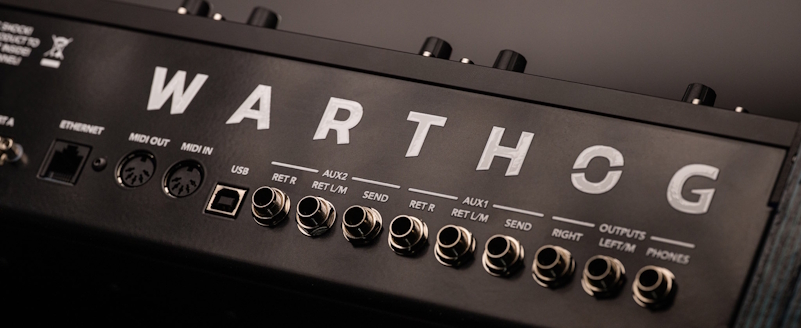Adamsynths “WARTHOG”
Let the musician raise their hand who has never been frustrated about forgetting a setting on their synthesizer. Especially the settings of a modular synthesizer. Recall sheet, marker, notes, hours of patching, tweaking, switching. And the recall will never be exactly the same twice. When Adam Miski thought about this and the idea of the Warthog took shape in his mind, the first thing that came to him was what a great opportunity it could be to save all the settings with its potentiometers, switches, cables everything included. All in all, he wanted his modular to remember everything for the future, what he tweaked out and connected on it today. Well, it was along this philosophy that the design and construction of the Warthog began.
Adamsynths is a small team of just a few passionate individuals. They love music and synthesizers, and their team includes musicians, programmers, electrical engineers, and more. The first idea for the Warthog was born in 2014, with actual design work starting in 2018. By 2021, the team was complete, and from that point on, they moved steadily toward their goal.
Meanwhile, during development, the team ventured down a side path that led to the creation of the Prima, their smallest desktop analog modular synthesizer. By the time Adamsyths announced this instrument, they had already been deep into working on their Total Recall modular synthesizer for a long time, and it completely defined their daily lives. Looking back on that period, the team almost went nuts by being so secretive about it.
Yes, the Warthog is that analogue modular synthesizer, which is able to save and remember everything - it can save all the positions of the potentiometers, the switches and modes, the snapshots, the hidden parameters and sure thing all the patch cables, like which was plugged where. So if Adam Miski has to summarize the awesomeness of this possibility, he’d say yes, he can save and recall Parameters again anytime. “I don’t feel like finishing the song I’m just working on? Then I’ll get back to it tomorrow, or in three weeks’ time perhaps.” - Adam Miski
And at this point another new possibility emerged. In the future users of the Warthog will be able to share their setups, patches, sequences with each other. And yes, naturally Adamsyths also provide tons of these presets for the users. (This can also stand for educational purposes). “Just imagine you take home a modular synthesizer and you can use a whole wide palette of patches right away, moreover you can modify or reshape, repatch all of them.“ - Adam Miski. The Warthog is completely equipped with all the necessary modules a musician may need. Analogue VCO, analogue Multimode VCF and VCA, VC ENV, Sync LFO and other analogue tools as well, like Noise, S&H, Glide, etc.

Now, let’s talk about what sets the Warthog apart from the usual East Coast or West Coast approaches. Nowadays, musicians have access to tons of complex, specialized, and generative modules. Many of these are highly interesting and intelligently designed ones, with their functionality focused on specific tasks.
But how does this manifest in the Warthog? All the modules of the Warthog are supervised by a system controller. This is how a completely controllable and programmable modular synthesizer is built. Thanks to this feature there are no limits of which parameters the Adamsyths team would like to move in real time. This determines that they have the possibility to further develop the Warthog’s control system in the future so that it can operate all parameters of the Warthog in accordance with a module designed for a specific purpose too. This can even be done on the basis of the user’s requirements.
The first 50 Warthog customers will receive lifetime access to any future premium software modules that Adamsynths develops, free of charge. Firmware and system updates will always remain free for everyone. To come to the point, the future expansion of the Warthog is not limited to integrating newer types of Adamsynths modules.
So how is the Warthog built? First of all there are the above mentioned analogue sound generating circuits, supplemented with a complex digital control. These are connected into the system controlling Central Unit, which performs the recall tasks, the MIDI interface tasks, and it’s also in charge of controlling all the parameters of the whole system. In short, the Central Unit is aware of everything that happens in the instrument and takes care of supervising and controlling it all.
The modules’ interface features an array of analog potentiometers, push buttons, and jack sockets, ensuring that the Warthog provides musicians with the same familiar experience as traditional modular synthesizers. Besides the front board controllers, there‘s the hidden parameters menu, where even more different, specific functions can be set for the selected module.
Within all of the saved patches Snapshots can be saved. With These, you can create and recall in real time even more variations within one patch. You can even morph them into each other. In case anyone feels like changing the mood of the melody by holding on to multiple potmeters at the same time on the Warthog, here’s the Mood Wheels designed for you. You can simultaneously assign multiple parameters to its wheels, or you can morph in between the Snapshots.
The Warthog is completely compatible with all the standard modular synthesizers. It uses the same V/OCT standard, knows PPQN sync, or TTL level GATE, TRIG and SYNC signals. On the PATCH cables there are the same signals present as on any other modular synthesizers.
 How to resolve AdBlock issue?
How to resolve AdBlock issue? 